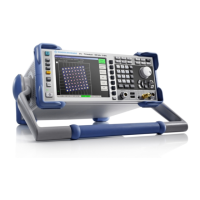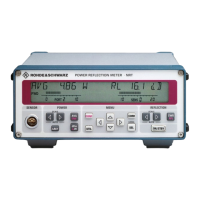R&S FSH Two-port measurements with the tracking generator
1309.6275.12 4.49 E-2
The R&S FSH now prompts you to connect its RF
i
nput to the tracking generator output so that
calibration can be carried out.
Connect the RF input of the R&S RSH3 directly to
the tracking generator output without the DUT.
Press the softkey CONTINUE to start calibration.
To abort calibration, press the fourth or fifth softkey
CANCEL.
When calibration is done, the R&S FSH outputs the
message "Calibration done!" in the lower area of the
display and (Cal) in the upper area of the display.
Connect the DUT between the RF input and the
generator's output.
The R&S FSH displays the transmission magnitude.
Values can be read off with, for example, the markers.
The transmission calibration remains valid until the center frequency or the span is changed on the
R&S FSH to such an extent that the new span falls outside the calibrated frequency range. UNCAL is
displayed in the upper area of the screen when calibration is no longer valid.
If the reference is changed after calibration, greater measurement uncertainty must be anticipated. The
R&S FSH retains the calibration data but displays APPROX in the upper area of the screen to indicate a
possible increase in measurement uncertainty (< 0.3 dB).
Changing any other of the parameters like bandwidth, detector, sweep time or measurement range has
no effect on measurement accuracy. This means they can be changed after calibration without any
reduction in accuracy.
When a data set for scalar transmission measurement is stored with calibration performed, the
calibration data can be stored along with the other settings (see Chapter 2, section "Saving Calibration
Data"). Thus, once the setting has been retrieved, measurement can be performed without first
performing a calibration.
Measurement on amplifiers:
With measurements on amplifiers, the reference must be shifted so that the amplifier's transmission
function can be seen on the screen. An increase of the reference level corresponds to an increase of
the input attenuation. The R&S FSH provides a reference setting for this purpose. The position of the
0 dB reference can be shifted to positive or negative values.

